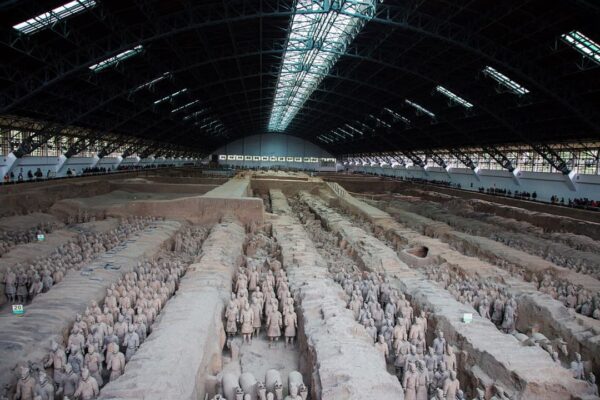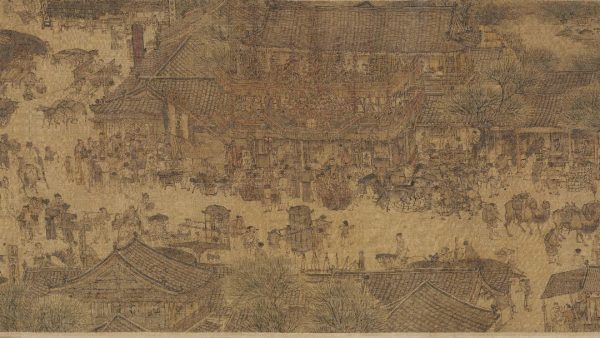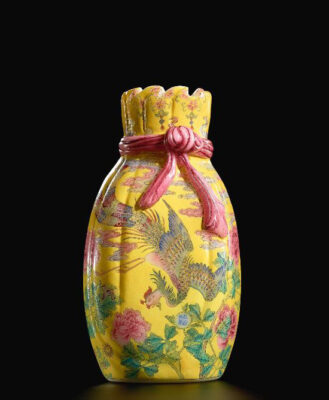Arte chino
Un viaje de diez mil años
«La caligrafía es el arte chino por excelencia, y de ella derivan todas las demás artes. Unas en sentido formal, porque los primeros caracteres escritos fueron modelos de las formas en cerámica y bronce. Otras en sentido estético, poesía y pintura que tomaron de ella el sentido de la abstracción, el vacío y el valor de la sugerencia implícito en todas ellas«
Isabel Cervera, historiadora del arte.

China – -Houmuwu Ding – Shang Dynasty

China – -Terracotta Army – Han Dynasty

Zhang Zeduan – Along the River During the Qingming Festival – 002 – 1085-1145 – Ink and color on Silk Palace Museum – Beijing

China – falangcai pouch-shaped glass vase – Qianglong Dynasty
Imágenes: Houmuwu Ding, también conocido como Simuwu Ding (vaso de vino). Dinastía Shang (c. 1300 – 1046 a.C.). Altura 133 cm. Foto de Mlogic ·· Ejército de Terracota. Dinastía Han (210-209 a.C.). Foto de Jmhullot ·· Zhang Zeduan: «A lo largo del río durante el festival Qingming» (detalle) (1085-1145) ·· Jarrón de cristal ( falangcai) con forma de bolsa, esmaltado, Qianglong (1693-1705). Imagen vía www.sothebys.com
Al igual que en el caso de la India, China es una cultura milenaria que se extendió por un amplio espacio geográfico, lo que le permitió crear una producción artística sobresaliente en cantidad y variedad, manteniendo además una notable continuidad. Debido a su situación geográfica, las influencias de otras grandes civilizaciones antiguas fueron escasas o incluso nulas.
La civilización china arcaica, «al igual que la babilónica o la egipcia bajo los faraones, fue una civilización eminentemente terrestre, basada en el cultivo de la tierra. Las tres poseían un suelo aluvial, que se hacía fértil anualmente por la crecida del río» (Rene Grousset: “El arte y la cultura china”, 1959). El Río Amarillo o Huang He fue, al igual que el Nilo en Egipto, o el Tigris y el Éufrates en Mesopotamia, el lugar donde se desarrolló la civilización china, siendo venerado y a la vez temido por sus frecuentes sequías. El amplio marco geográfico de la cultura china, la variedad de paisajes y climas, y la gran cantidad de recursos naturales garantizó que el arte chino pudiera realizarse en una amplia gama de materiales.
Si bien las obras más antiguas del arte chino son las obras de cerámica de las culturas Yangshao y Peiligang, son los bronces creados durante la Edad del bronce (dinastías Xia, Shang, y Zhou) las primeras obras maestras del arte chino. Así, «la fundición china de bronce precedió a la de cualquier otra civilización y destaca por su sofisticación artística y su virtuosismo técnico«. (Museo Británico, «Arte chino»). El jade, que se comenzó a trabajar durante la llamada cultura Liangzhu (3400–2200 a.C.) fue uno de los materiales más apreciados por los artistas chinos, alcanzando un punto culminante durante la dinastía Qing (1644 –1911)
En porcelana los artistas de los periodos Yuan, Ming y Qing crearon algunas de las obras más apreciadas hoy en día. Por su parte, la pintura y la caligrafía china, por su importancia e interés se trata en un ensayo independiente dentro de esta web.
Tras el fin de la Dinastía Qing, comienza el arte moderno en China, con más influencias de Occidente. Tras la destrucción provocada por la llamada “Revolución Cultural”, el arte contemporáneo chino se manifiesta en pintura, escultura, fotografía, cine, vídeo, y performance, creciendo su apreciación tanto dentro como fuera de China
G. Fernández · www.theartwolf.com
Chinese Art
The journey of ten thousand years
«Calligraphy is the Chinese art par excellence, and all the other arts derive from it. Some in a formal sense, because the first written characters were models of the forms in ceramics and bronze. Others in the aesthetic sense, poetry and painting, which took from calligraphy the sense of abstraction, emptiness and the value of suggestion implicit in all of them«
Isabel Cervera, art historian.

China – -Houmuwu Ding – Shang Dynasty

China – -Terracotta Army – Han Dynasty

Zhang Zeduan – Along the River During the Qingming Festival – 002 – 1085-1145 – Ink and color on Silk Palace Museum – Beijing

China – falangcai pouch-shaped glass vase – Qianglong Dynasty
Images: Houmuwu Ding, also known as Simuwu Ding (wine vessel). Shang Dynasty (c. 1300 – 1046 BC). Height 133 cm. Photo by Mlogic ·· Terracotta Army. Han Dynasty (210–209 BC). Photo by Jmhullot ·· Zhang Zeduan: “Along the River During the Qingming Festival” (detail) (1085–1145) ·· An enamel falangcai pouch-shaped glass vase, Qianglong (1693-1705). Image via www.sothebys.com
As in the case of India, China is a millenary culture that spread over a wide geographical area, creating an outstanding artistic production in terms of quantity and variety, while maintaining a remarkable continuity. Due to its geographical location, it had little or no influence from other great ancient civilisations.
The archaic Chinese civilization, “like the Babylonian or the Egyptian under the Pharaohs, was pre-eminently a land civilization, based on the tilling of the soil. All three possessed an alluvial soil, annually made fertile by the river flood” (Rene Grousset: «Chinese Art and Culture», 1959). The Yellow River or Huang He was, like the Nile in Egypt, or the Tigris and Euphrates in Mesopotamia, the place where Chinese civilisation developed, the river being both revered and feared because of its frequent and destructive droughts. The broad geographical setting of Chinese culture, the variety of landscapes and climates, and the wealth of natural resources ensured that Chinese artists could use a wide range of materials.
While the oldest works of Chinese art are the ceramic from the Yangshao and Peiligang cultures, the bronzes created during the Bronze Age (Xia, Shang, and Zhou dynasties) are the true first masterpieces of Chinese art. Thus, “Chinese bronze metal casting preceded that of any other civilization and is noted for its artistic sophistication and technical virtuosity.” (British Museum, “Chinese Art”). Jade, which began to be used during the Liangzhu culture (3400-2200 B.C.), was also a coveted material, reaching a high point during the Qing dynasty (1644-1911).
Porcelain artists from the Yuan, Ming and Qing periods created some of the most coveted and well-known Chinese works of art. Chinese painting and calligraphy, for its importance and interest, is dealt with in a separate essay on this website.
After the end of the Qing Dynasty, modern art in China showed more influences from the Western world. After the disruption caused by the Cultural Revolution, contemporary Chinese art includes painting, sculpture, photography, film, video and performance, and its appreciation is growing both inside and outside China.
G. Fernández · www.theartwolf.com




